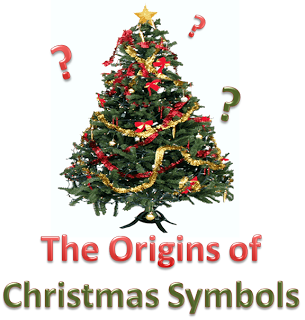Ever wonder why we chop down a tree and put it up in our living room, covered in lights? Or why Santa flies through the sky? Me too! Below are some of the first things I think of when I think of Christmas...what's missing from the list?
Christmas Tree
Early Origins:
The use of evergreen trees, wreaths, and garlands to symbolize eternal life was a custom of the ancient Egyptians, Chinese, and Hebrews. Tree worship was common among the pagan Europeans and survived their conversion to Christianity in the Scandinavian customs of decorating the house and barn with evergreens at the New Year to scare away the devil and of setting up a tree for the birds during Christmastime; it survived further in the custom, also observed in Germany, of placing a Yule tree at an entrance or inside the house during the midwinter holidays. (source)
Christian Origins:
While several theories exist, one of the most commonly accepted is the association with the "tree of paradise". On December 24th, a medieval mystery play was held in celebration of Adam and Eve in various countries. In the play, a tree was decorated with apples (representing the forbidden fruit) and wafers (representing the Eucharist). This tree became a popular symbol and became tied to Christmas...the apples were replaced with colorful glass balls and lights were added to make the commonly seen tree of today. (source)
Applying it Today:
The tree is a beautiful way to celebrate Christmas in your home. This year, as you put up your tree, talk about creation and how God created vegetation - including trees - on the third day. As you string the lights, talk about how Jesus is our light. Include red balls in your decorations and share the story of how the balls used to be apples, representing our original sin (better yet, include some apples!). As you top your tree with a glittering star, share the story of the Maji and how they followed the star to bring their gifts to the Messiah (Matthew 2:11).
Santa Claus
Early Origins:
"During the Christianization of Germanic Europe, this figure may have absorbed elements of the god Odin, who was associated with the Germanic pagan midwinter event of Yule and led the Wild Hunt, a ghostly procession through the sky." (source)
Christian Origins:
Santa Claus, as he exists today, sees his origin in Saint Nicholas, the 4th century Christian bishop and gift giver. He would, in secret, leave gifts for the poor and coins in the shoes of families that left them outside their door.
Applying it Today:
Celebrate Saint Nicholas on December 6th (here's an idea how). Consider introducing Santa to young children as the fictional character he is, talking about how he represents Saint Nicholas and brings gifts just like Saint Nick did.
Advent Wreath
Early Origins:
The circular shape has long been associated with the concept of "eternal / no beginning or end". Early origins of pre-Christian Germanic groups used wreathes with lit candles during the cold and dark December days as a sign of hope and warmth. (source)
Christian Origins:
"Research by Prof. Haemig of Luther Seminary, St. Paul, points to Johann Hinrich Wichern (1808–1881), a Protestant pastor in Germany and a pioneer in urban mission work among the poor as the inventor of the modern Advent wreath. To help his students keep track of the countdown to Christmas, he (in 1839) built a large wooden ring with 19 small red and 4 large white candles. A small candle was lit every weekday during Advent and, on Sundays, a large white candle was lit." (source)
Applying it Today:
Create an Advent wreath with your family this Christmas season (see how to create your own and learn more about the colors of the candles here). Talk about the significance of the four candles as one is lit each Sunday. Consider lighting it each night during dinner, and making it a special part of your Advent season.
Copyright 2013 Jen Frost
About the Author

Guest
We welcome guest contributors who graciously volunteer their writing for our readers. Please support our guest writers by visiting their sites, purchasing their work, and leaving comments to thank them for sharing their gifts here on CatholicMom.com. To inquire about serving as a guest contributor, contact editor@CatholicMom.com.



.png?width=1806&height=731&name=CatholicMom_hcfm_logo1_pos_871c_2728c%20(002).png)
Comments